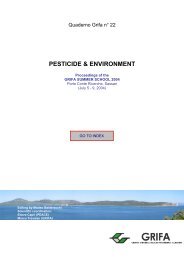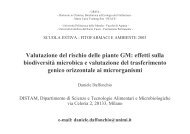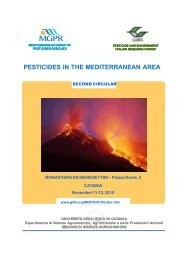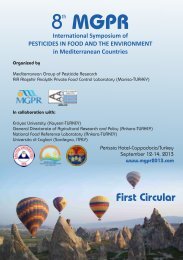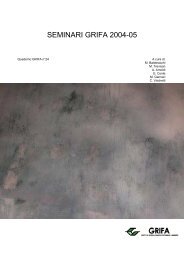International Congress BIOLOGICAL PRODUCTS - Gruppo di ...
International Congress BIOLOGICAL PRODUCTS - Gruppo di ...
International Congress BIOLOGICAL PRODUCTS - Gruppo di ...
You also want an ePaper? Increase the reach of your titles
YUMPU automatically turns print PDFs into web optimized ePapers that Google loves.
In particular the farming year 2000/2001 has been characterized by a mild and humid winter and by low temperatures in<br />
April, which have damaged the early varieties and the cultivars that are susceptible to some fungal <strong>di</strong>seases, mainly<br />
yellow and brown rust.<br />
In the table 1 the production indexes of the varieties tried out over the three-year period 1998-2001 are summarized.<br />
The cultivars which highlight the best performances are Abbondanza, Eureka and Serio which, in that period, have<br />
always given indexes above average. Also the mean index of the variety Centauro is above 100, while the production<br />
index of the cultivar Pandas decreases dramatically because of the chilling damages suffered during the grain season<br />
2000/2001.<br />
Among the varieties tested only during the farming year 2000/2001 the index of the cultivar Sirmione is below average,<br />
while Etecho and Guadalupe are in evidence for their very high indexes, even if for these varieties it is necessary to wait<br />
for further experimental evidences.<br />
Qualitative characteristics<br />
On a grain sample, mixture of the three repetitions, technological analyses (alveogram, falling number, protein and<br />
gluten content) have been performed in order to establish the qualitative characteristics of the harvested product.<br />
Examining the graph 2, where the mean data of the thirteen varieties common to the three years of trials are reported, it<br />
can be observed that W values are basically low, whereas the ratio P/L in<strong>di</strong>cates a tendential imbalance because of an<br />
excess of tenacity. Probably this qualitative decay is due to an unfavourable seasonal trend both in 1998/1999 and in<br />
2000/2001, and to a reduced nitrogen availability during the main stages of the vegetative cycle. Only in the grain<br />
season 1999/2000 the quality appears me<strong>di</strong>ally sufficient, so that in this case most of the varieties can be set in the<br />
respective qualitative classes accor<strong>di</strong>ng to the Synthetic Quality Index (ISQ) calculated on the basis of the protein<br />
content and of the alveographic and farinographic characteristics.<br />
Conclusions<br />
In general the results which have been obtained demonstrate that organic agriculture gives the chance for satisfying<br />
yields combined to a middle-low technological quality, anyhow sufficient for the production of biscuits and<br />
breadmaking flours. The improvement of technological quality for the wheat cultivated with the organic methods<br />
requires a careful varietal choice, and the use of techniques able to guarantee an adequate availability of assimilable<br />
nitrogen in the soil.<br />
*CERMIS – Centro Ricerche e Sperimentazione per il Miglioramento Vegetale “N. Strampelli”, Tolentino (MC) Email:<br />
cermis@tin.it<br />
PDF creato con FinePrint pdfFactory versione <strong>di</strong>mostrativa http://www.secom.re.it/fineprint<br />
88



